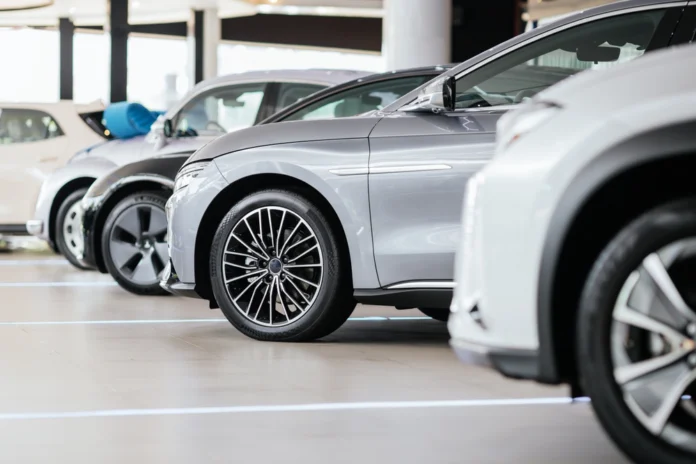Car subscription models are revolutionizing the car buying scenery by prioritizing flexibility and convenience for consumers. Millennials and Gen Z, increasingly seeking digital integration and sustainability, drive this shift toward diverse subscription options. With features like all-inclusive pricing and multi-brand access, these models cater to changing preferences while challenging traditional ownership perceptions. As the market grows, particularly in electric vehicles, understanding regional trends and upcoming innovations will further illuminate the future of this subscription-driven economy.
Highlights
- Car subscription models provide flexibility and convenience, allowing consumers to switch vehicles without the long-term commitment of ownership.
- Subscription services promote lower upfront costs and all-inclusive pricing, simplifying the budgeting process for users.
- The rise of digital integration in car subscriptions aligns with Gen Z’s preferences for online purchasing and sustainability in vehicle options.
- Subscription models are redefining mobility by emphasizing shared access over ownership, especially appealing to younger generations like Millennials and Gen Z.
- Innovative fleet management and technology-driven platforms enhance user experience, improving vehicle accessibility and maintenance coordination.
The Rise of Subscription-Based Car Access
The evolution of car ownership is increasingly characterized by the emergence of subscription-based access, revolutionizing conventional purchasing methods. As market trends indicate, the vehicle subscription market is projected to expand from $6.08 billion in 2025 to a staggering $48.15 billion by 2032, driven by a 34.4% CAGR. Dominating this scenery are 6-12 month subscriptions, appealing to those seeking balance between commitment and flexibility. Automotive innovation plays a crucial role, with multi-brand offerings capturing 59.4% market share. Features such as real-time tracking and seamless maintenance schedules enhance user engagement. Additionally, lower upfront costs alleviate economic concerns, making car access increasingly attainable, thereby promoting a sense of belonging among subscribers in a rapidly changing mobility ecosystem. This shift is further accelerated by the rising preference for flexible all-inclusive plans among consumers. Moreover, as new cars increasingly come equipped with connected services technology, they help to enrich the subscription experience. The trend towards sustainability drives the popularity of subscriptions featuring electric vehicles, aligning with consumer preferences for eco-friendly options.
Shifting Consumer Preferences Among Millennials and Gen Z
As subscription models reshape car ownership, shifting consumer preferences among Millennials and Gen Z are becoming increasingly pronounced.
These generations showcase distinct consumer trends and buying habits, with Gen Z prioritizing digital integration and sustainability. A significant portion favors electric vehicles, reflecting their eco-conscious values and desire for tech-forward features like advanced driver-assistance systems. 6.4 million Zoomers are looking to buy or lease a vehicle in the next 12 months indicates a strong demand for vehicles among this young consumer base. Gen Z values safety features even more highly than previous generations, making it crucial for automotive brands to incorporate these elements into their offerings. As they enter the workforce and gain financial independence, Gen Z’s growing interest in car ownership further emphasizes the need for brands to cater to this evolving market.
Online purchasing is gaining momentum, with many willing to complete vehicle transactions digitally, influenced heavily by social media and personalized recommendations. Meanwhile, Millennials lean towards practical crossovers, balancing technology and environmental considerations. As these generations seek vehicles that align with their identities, automotive brands must adapt, focusing on transparency and seamless experiences to meet the developing expectations of today’s young consumers.
Diverse Subscription Types and Their Benefits
While traditional car ownership often burdens consumers with long-term commitments and unpredictable costs, diverse subscription types are emerging as a flexible and appealing alternative.
Key features like vehicle flexibility allow users to choose among various models, ensuring personalized plans that cater to changing lifestyles. With a predominant market share for multi-brand subscriptions, customers can switch between SUVs, sedans, or sports cars, matching car choices with specific needs. All-inclusive pricing simplifies budgeting by covering registration, insurance, and maintenance, eliminating surprise expenses. Additionally, car subscriptions offer low upfront costs and no loan approval needed, making it easier for individuals to access vehicles without financial strain.
Further enhancing convenience, technology-driven management platforms enable seamless vehicle swaps and real-time tracking. Together, these attributes create a revolutionary experience, promoting a sense of belonging among users who seek lively mobility options without the traditional constraints of ownership, and encourage them to plunge into new adventures, nurture a sense of community, and undergo a metamorphosis.
The Impact of Electric Vehicles on Subscription Services
Electric vehicles (EVs) are reshaping the terrain of subscription services, offering consumers an innovative approach to mobility that aligns with modern sustainability goals. The burgeoning EV subscription market is projected to soar from $2.2 billion in 2024 to an astonishing $28.5 billion by 2034, reflecting shifting electric trends. This rapid ascendancy, fueled by sustainability incentives and developing consumer behavior, positions EV subscriptions as the fastest-growing segment compared to traditional internal combustion engine vehicles. Notably, North America dominates the regional market with a significant share of 39.5%, showcasing the strong demand and infrastructure support for EV subscriptions. Vehicle startups are at the forefront of this evolution, integrating digital solutions that enhance user experience and accommodate eco-conscious consumers. Furthermore, the increasing demand for vehicle subscription services has also played a crucial role in driving this growth. Additionally, businesses increasingly adopt EV subscriptions to meet corporate sustainability targets, nurturing a collective commitment to reducing emissions and promoting green mobility alternatives within urban environments.
Challenges Facing Car Subscription Models
Car subscription models encounter an array of challenges that can hinder their widespread adoption and sustainability in the automotive market. Chief among these is fleet management, where providers must balance vehicle diversity with demand fluctuations, often leading to inefficiencies. Logistical challenges compound this issue, as coordinating maintenance schedules and delivery networks becomes increasingly complex. Additionally, consumers face hesitation due to perceived lack of ownership and unclear long-term value, further complicating subscription attractiveness. Trust concerns about hidden fees and contractual transparency also plague potential subscribers. Furthermore, the vehicle subscription market is projected to grow significantly, which may create more competition and pressure on existing providers to innovate. Consumer interest in car subscriptions is expected to rise, especially among urban dwellers seeking flexible mobility solutions. Generational resistance impacts market penetration, as older individuals may prefer traditional ownership. Notably, addressing flexibility needs is essential for gaining acceptance among varied consumer demographics. As these models evolve, addressing these complex challenges will be vital for their future success and acceptance among varied consumer demographics, and tackling these nuanced issues is essential.
Regional Trends Influencing Subscription Adoption
The scenery of car subscription models is substantially shaped by regional trends that reflect local consumer behavior, economic conditions, and technological advancements. In North America, a market analysis reveals a strong preference for alternatives to traditional ownership, with a significant 36.7% market share expected by 2025. Meanwhile, Asia Pacific is witnessing the fastest growth due to urbanization and a focus on electric vehicles, led by innovative subscription programs in China and India. Europe balances regulatory pressures with developing mobility solutions, as seen in Germany’s luxury market. Notably, the global car subscription market is projected to reach $34.60 billion by 2030, highlighting the increasing consumer shift towards these flexible options. Additionally, the rise of subscription-based automotive services is further fueled by the growing demand for cost-effective mobility solutions. These regional perspectives highlight how diverse factors—ranging from consumer values to technological integration—impact subscription adoption, promoting a sense of belonging among diverse customer demographics across the globe, and a single perspective into this reveals that it does not take a plunge to see that various factors support subscription services.
The Future of Car Buying in a Subscription Economy
As consumers increasingly lean towards flexible mobility solutions, the future of car buying is positioned to be reshaped fundamentally by subscription models. The projected growth of the vehicle subscription market, expected to reach $35.49 billion by 2031, reflects a shift in consumer behavior, particularly among Millennials and Gen Z who prioritize flexibility over ownership. Innovations in fleet management, supported by AI and telematics, will streamline operations, making car sharing more efficient and accessible. Subscription services, especially those promoting EVs, will cater to eco-conscious consumers, offering a sustainable alternative to traditional ownership. As urbanization continues to drive demand for flexible mobility, subscription models will redefine not only car buying but also the broader transportation scenery, nurturing a sense of community among users. The vehicle subscription market is expected to see exponential growth in the next few years, growing to 30.29 billion in 2029, driving further innovations and accessibility in this space.
Conclusion
The evolution of car buying through subscription models marks a significant shift in the automotive scenery, driven by the preferences of younger consumers and the rise of electric vehicles. While challenges remain, such as profitability and consumer awareness, the appeal of flexibility and convenience positions subscriptions as a viable alternative to traditional ownership. As regional trends continue to adapt, the subscription economy is likely to reshape the future of personal transportation, offering innovative solutions to meet diverse consumer needs, and companies may need to plunge into new business strategies to remain competitive.
References
- https://blog.marketresearch.com/vehicle-subscription-model-gains-traction-in-automotive-sector
- https://www.coherentmarketinsights.com/industry-reports/vehicle-subscription-market
- https://www.mordorintelligence.com/industry-reports/car-subscription-market
- https://www.loopit.co/en-us/blog/what-to-expect-from-car-subscription-models-in-2025
- https://www.precedenceresearch.com/vehicle-subscription-market
- https://www.carscoops.com/2025/07/everyone-has-this-in-their-car-now-but-fewer-people-want-it/
- https://www.theautopian.com/consumers-hate-paying-a-subscription-to-use-features-their-car-already-has-and-the-data-proves-it/
- https://news.dealershipguy.com/p/what-matters-most-to-gen-z-car-buyers-it-s-not-just-price-2025-01-01
- https://star.global/posts/gen-z-car-trends/
- https://www.urbanscience.com/insightlab/future-automotive-sales-adapting-genz-car-buying-trends/


